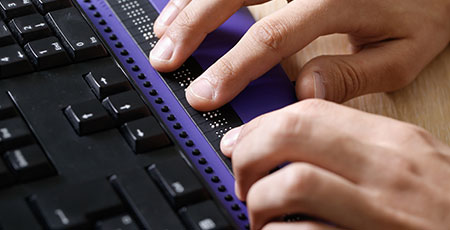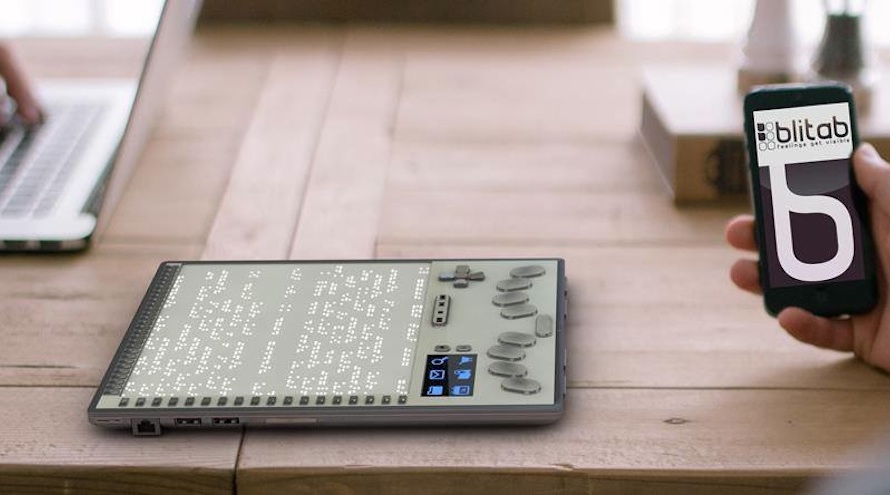OCR Devices for the Blind: Changing Print to Speech in Real-Time
OCR Devices for the Blind: Changing Print to Speech in Real-Time
Blog Article
Discover Cutting-edge Tools Made for the Aesthetically Damaged
The development of innovative tools for the visually impaired represents a substantial innovation in ease of access and independence. Technologies such as wise glasses with AI abilities and mobile applications designed to provide acoustic descriptions are reshaping daily experiences for users. Furthermore, wearable devices that utilize haptic comments improve ecological recognition, while modern Braille developments provide brand-new means to engage with message. As these devices remain to evolve, their effect on the lives of those with visual problems elevates essential inquiries regarding the future of inclusivity and freedom in different elements of life. What lies in advance in this technological landscape?
Smart Glasses for Navigation

Smart glasses designed for navigation are changing the means aesthetically impaired people interact with their atmosphere. These sophisticated devices utilize a mix of video camera modern technology, expert system, and auditory comments to offer real-time information concerning surroundings. By utilizing challenge discovery systems, clever glasses can notify individuals to potential dangers, making it possible for safer mobility in both acquainted and unknown settings.
The assimilation of GPS innovation even more boosts navigation capacities, allowing customers to obtain auditory directions as they relocate. This hands-free strategy not only fosters freedom but also encourages visually impaired people to navigate urban landscapes with raised confidence. In addition, several clever glasses are furnished with attributes that identify landmarks and road signs, supplying contextual information that improves the user experience.
Moreover, the advancement of these tools is consistently advancing, with firms functioning to enhance the precision of object acknowledgment and expand the array of navigational functions. As wise glasses become a lot more available and budget-friendly, they hold the prospective to dramatically transform day-to-day live for aesthetically damaged customers. Inevitably, these ingenious tools represent a crucial step toward inclusivity, offering boosted movement and a greater feeling of autonomy for individuals navigating the globe around them.

Mobile Application for Daily Living
How can mobile applications enhance the lives of aesthetically damaged individuals? Mobile applications are transforming the method visually damaged customers navigate their settings, manage daily jobs, and access info. These applications supply crucial support through various performances, cultivating freedom and enhancing quality of life.
A number of cutting-edge mobile applications are designed specifically for daily living. Apps like Be My Eyes attach aesthetically impaired users with sighted volunteers through video clip calls, allowing them to receive real-time support with jobs such as checking out labels or browsing unfamiliar spaces. Seeing AI, established by Microsoft, uses artificial intelligence to explain surroundings, reviewed message, and identify objects, effectively changing a smart device right into an effective device for day-to-day aid.
Additionally, navigation applications tailored for the aesthetically damaged, such as Aira and BlindSquare, offer audio-based instructions and ecological information, allowing customers to traverse their surroundings securely and confidently. Beyond navigation and prompt support, mobile applications also support organization and task administration, with features that aid individuals set tips, produce order of business, and track visits. In recap, mobile applications function as essential sources, equipping aesthetically damaged people to lead more independent and satisfying lives.
Wearable Technologies for Support
Empowerment via technology is increasingly noticeable in the realm of wearable gadgets made to help aesthetically impaired people. These ingenious tools integrate seamlessly right into day-to-day live, improving navigation and supplying crucial responses to users. Clever glasses outfitted with cams can recognize faces and read text out loud, permitting customers to connect even more confidently in professional and social settings.
An additional notable innovation is the usage of haptic responses systems in wearable devices. These systems make use of vibrations or other responsive signals to share information about the customer's atmosphere, such as barriers or modifications in surface, improving mobility and security. Wearable modern technologies likewise include wristbands that connect to smart devices, alerting users to notifications via refined vibrations, thus enhancing connection without reliance on aesthetic signs.
As these modern technologies proceed to evolve, they are not only improving independence for aesthetically damaged individuals yet likewise cultivating a better feeling of addition in culture. By connecting the void in between challenges dealt with in daily living and the potential for autonomy, wearable modern technologies function as critical tools in the quest for equality and empowerment for those with aesthetic disabilities.
Audio Description Tools
Sound summary devices play a vital function in boosting accessibility for aesthetically damaged people, giving them with the capability to involve with aesthetic media. Assistive technology for the blind. These tools use narrated summaries of crucial visual aspects in films, television programs, and live efficiencies, guaranteeing that customers can completely understand the context and feelings shared with visuals
Sound description can be incorporated into different platforms, including streaming solutions, movie theater screenings, and live cinema. Lots of prominent streaming solutions useful link now consist of audio summary as an accessibility function, allowing viewers to select it easily. Along with conventional media, specialized apps likewise exist, supplying audio descriptions for art events, museums, and various other cultural events.
The efficiency of audio summary pivots on the ability of the narrators, that need to share visual information succinctly without diminishing the initial sound. Advancements in this area from this source are additionally leading the way for even more personalized experiences, where users can adjust the level of information and pacing according to their choices.
Braille Innovations and Tools
Braille advancements and tools have significantly transformed the means aesthetically damaged individuals engage with message and information. Modern improvements have actually led to the advancement of flexible devices that improve literacy and self-reliance amongst customers. Especially, Braille present modern technologies have progressed, permitting for dynamic analysis experiences. These devices convert electronic message into Braille, enabling users to access a vast range of information on computers, tablet computers, and mobile phones.
In addition, mobile Braille notetakers incorporate conventional Braille input with modern functionalities, helping with note-taking, scheduling, and file modifying on the go. Braille displays and notetakers. These small tools usually feature text-to-speech capabilities, bridging the void between Braille and acoustic details
In addition, ingenious Braille printers have emerged, allowing individuals to generate Braille labels, papers, and instructional products effectively. This access cultivates better involvement in expert and instructional environments, ultimately promoting inclusivity.
Moreover, research right into wise Braille modern technologies continues to increase. Gadgets that integrate expert system are being checked out to provide real-time navigating assistance and contextual information, improving the individual experience in diverse settings. On the whole, these innovations show a dedication to encouraging visually impaired people via modern technology, ensuring they can easily accessibility and involve with the world around them.

Verdict
The advancement of cutting-edge tools for the visually impaired dramatically boosts independence and top quality of life. These technologies not just foster greater incorporation yet additionally advertise autonomy in daily activities, eventually contributing to a more available and equitable culture for aesthetically impaired individuals.
As wise glasses come to be much more budget friendly and accessible, they hold the prospective to dramatically change daily life for aesthetically impaired individuals. Mobile applications are transforming the means visually impaired individuals browse check that their environments, take care of day-to-day jobs, and gain access to information. Applications like Be My Eyes link visually impaired individuals with sighted volunteers using video clip telephone calls, enabling them to get real-time support with jobs such as checking out labels or browsing strange spaces.Additionally, navigating applications tailored for the aesthetically impaired, such as Aira and BlindSquare, provide audio-based instructions and ecological information, making it possible for users to traverse their environments safely and confidently.The development of ingenious devices for the aesthetically impaired significantly enhances self-reliance and top quality of life.
Report this page